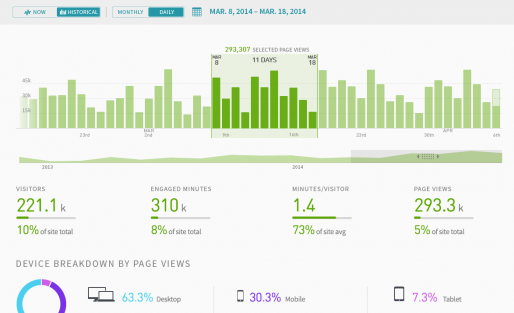There are many of us who attend multiple media industry events a month – I know you or your faces. Event fatigue is real: the same talking points, the same people speaking and often not many outcomes to walk away with and apply to your business.
However, every once in awhile you attend an event that reminds you why it’s worth your time to get out of the office, network, and create an improv comedy skit. Wait, what?
If you’ve seen the coverage of the past Collab/Space events on this website (found here, here and here), the improv bit might not be news to you, as it’s part of every PBS MediaShift workshop. If you haven’t, these workshops use improv and other methods to facilitate collaboration between media and technology professionals.
Sounds great, but do they work? Do people actually collaborate and make changes that affect our industry? For me, it did.
In September, I presented at Collab/Space Chicago on behalf of Parse.ly. I showed off what we do, and talked about our goals as a company. During the facilitated Q&A, moderator Brian Reich identified what looked like our biggest challenges. Then, I sat down with a group of fellow media professionals and worked out solutions to them.
>>>>Related: Collab/Space Austin will be focused on analytics and impact at the University of Texas on April 16, 2015. More info here.<<<<
In the spirit of Collab/Space, I’m sharing how the challenges we discussed contributed to the changes that we’ve made to our new analytics platform, which we just announced.
Challenge 1: What new data inputs are needed to further enhance the business?
With the new platform, we’ve added a myriad of new data sources to not only enhance our business, but the media businesses that bank on our services, quite literally. These new inputs are centered around audience growth, loyalty and engagement. They include engaged time, device breakouts, charts on traffic recirculation and audience loyalty segmentations.
We took the advice we got at Collab/Space, coupled with incredible feedback from clients, to not just find new data inputs, but to use the ones we have to provide context. Many discussions my breakout group had were about how to understand existing metrics better. When they’re viewed in concert together instead of broken up across screens we’re confident this need will be met.
Challenge 2: How do you get publishers to expand their audiences?
Successfully expanding an audience, or reaching any goal set internally, really depends on how well you can apply available data. Suggestions for how to do this at the Collab/Space event included: finding ways to identify what did or didn’t perform as expected, pointing out opportunities to users, or presenting hypothesis, suggestions, solutions or hints throughout the platform — in the case of Parse.ly.
Our take on this challenge in the new release is twofold. First, our team looked for ways to include benchmarking. For example, users can look at a number or percentage and know how it compares to the rest of the site. Second, our UI/UX and design team’s first priority was to keep the platform easy to understand and use, so that solutions would be unearthed right out of the box.

Challenge 3: How do you help customers to monetize the intelligence?
Unsurprisingly, we also hear this question often from our customers. The main takeaway from the Collab/Space group was to try to tease out the difference between informing a reader and having the reader take an action (subscribing, paying, coming back, etc.) Again, this also comes down to having access to data that people can understand and use to collaborate — and at Parse.ly that means making analytics accessible and consistent across multiple business units within digital publishers. This isn’t a platform just for editorial — it serves the needs of product teams, ad sales, and so on, and is a comprehensive way for everyone to work off the same data, which our CEO, Sachin Kamdar, has written about here before.
This last point is where the latest version of Parse.ly really comes full circle. It’s never been easier to see what factors contribute to reader action. We’ve seen early users monetize that intelligence, by connecting analytics with paywalls to make sure offers are made to people when they’ll pay, or providing advertisers with detailed information about their sponsored content campaigns.
What’s Left?
Though I feel like we did a great job of meeting these challenges with our release, there’s always more work to be done. A topic that the Collab/Space team brought up that we’d love to be able to address was incorporating offline actions and impact. There’s great work being done on those topics by the people at CIR.org and The Media Impact Project, and we’re hoping to find ways to assist their efforts.
>>>>Related: Collab/Space Austin will be focused on analytics and impact at the University of Texas on April 16, 2015. More info here.<<<< Clare Carr is the Director of Marketing at Parse.ly, a partner of digital publishers that provides clear audience insights through an intuitive analytics platform. She spent five years as Director of Marketing and Online Operations at Greentech Media, the renewable energy industry’s premiere information firm. Previous to that, she did digital marketing and business development at ThePoint.com, the precursor to Groupon. Originally from Ohio, she graduated from the University of Virginia with a degree in Environmental Sciences.


